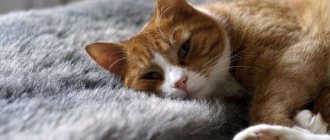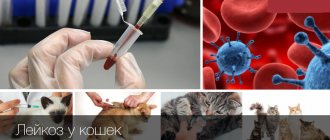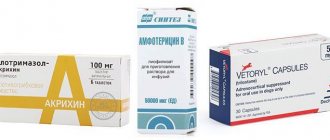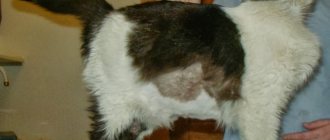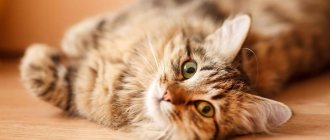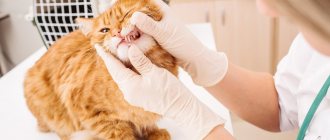Manifestation and forecasts
The term “anemia” means a reduction in the number of red blood cells or hemoglobin, which normally should be 90-150 g/l.
Against the background of this condition, tissues and organs cease to receive enough oxygen for further normal functioning.
As a result of oxygen starvation, the functioning of the entire body is disrupted.
How does the disease appear?
With the development of a pathological condition, the shade of the gum tissue first changes. During the examination, the owner or veterinarian notices that the gums have acquired a pale tint. If you have such symptoms, it is recommended to immediately take a blood test.
The behavior of sick pets changes noticeably. They become lethargic, lose stamina, and get tired quickly.
What happens if the disease is ignored
If anemia is not detected promptly and treated, the likelihood of death increases.
With the development of anemia against the background of cancer, the prognosis depends on the degree of the pathology.
Prevention of anemia
The most important condition for preventing anemia in a kitten or adult cat is a balanced diet. This term refers to a varied diet, correctly selected portion sizes and number of meals.
The nutritional system is compiled individually, taking into account the age, weight, lifestyle and health status of the animal. Additionally, the animal can be given vitamin supplements; they are prescribed based on test results.
It is important to regularly prevent flea and worm infestations. It is also necessary to vaccinate your pet according to the schedule approved by the veterinarian.
Important! Since anemia often occurs as a consequence of a chronic illness, the best prevention of anemia is regular examination by a doctor.
Anemia is a common blood disease among animals. The easiest way to normalize the condition is to review your cat's diet by adding foods rich in protein and iron. If your pet shows alarming signs of illness, you should immediately contact your veterinarian and get a blood test. Timely treatment increases the chances of success several times.
Types of anemia
Depending on the factors that provoked the development of the disease, there are several types of anemia.
According to the method of self-healing, the disease can be of two types:
non-regenerative – characterized by the destruction of more red blood cells than the body is capable of producing (in other words, there is no replacement process, which leads to a rapid deterioration in the animal’s health);- regenerative - destroyed red blood cells are replaced with new ones.
Based on the type of provoking factor, the following forms of the disease are distinguished:
Hemolytic
Develops against the background of destruction of blood cell structures. Accompanied by a significant decrease in the concentration of red blood cells and hemoglobin in the blood.
An additional symptom indicating the disease is the manifestation of jaundice.
Autoimmune form
It can be acquired or congenital. In the first case, the cause of the disease is the toxic effect on the body of toxic substances, the vital activity of parasites and viruses.
The second type occurs as a result of changes in cells at the genetic level, which leads to disruption of their functioning.
Posthemorrhagic
The pathology can occur in acute and chronic form, with a transition to the second stage noted in the absence of therapeutic measures over a long period of time.
The cause of the disease is bleeding caused by injury to internal organs and tissue structures. Against the background of blood loss, the body loses some red blood cells, and the level of hemoglobin also decreases.
Infectious
It develops as a result of the presence in the animal’s body of pathogenic microorganisms that have hemolytic properties, i.e. promote the destruction of red blood cells. These can be streptococci, salmonella, immunodeficiency viruses, leukemia and others.
Aplastic
A decrease in the number of red blood cells in a cat is possible if the bone marrow is not able to fully cope with bleeding.
The pathological condition is often accompanied not only by a decrease in hemoglobin, red blood cells and leukocytes, but also by the development of an inflammatory process.
Among the provoking factors of this type of disease are leukemia, some medications, and radiation.
Hypoplastic
Develops against the background of abnormal synthesis of blood cells. The causes of this condition include disruption of the bone marrow, deficiency of elements directly involved in the hematopoietic system.
To compensate for the lack of red blood cells in the blood, it is enough to provide the body with iron, copper, protein, cobalt, and B vitamins.
Nutritional
This is the most common type of anemia in cats. It can be caused by poor nutrition or poor absorption of micronutrients.
In most cases, the disease is diagnosed in young individuals under 1.5 years of age.
What to feed the animal
In case of blood diseases, in addition to proper treatment, the nutrition of the sick animal is of no small importance. The diet should contain complete proteins. For this purpose, a sick cat’s diet should include lean beef, turkey, and chicken. It is useful to give offal twice a week. An obligatory component of the diet should be vegetables rich in iron, copper, cobalt and vitamins. For proper bowel function, lactic acid products are recommended.
Nutrition for anemia
Reasons that cause pathology
Having examined the main types of anemia in cats, we can highlight the following factors that contribute to the appearance of pathology:
diseases of infectious origin;- taking medications;
- the presence of parasites in the body;
- inflammation;
- diseases of internal organs that occur in a chronic form;
- lack of useful elements;
- poisoning with toxic substances;
- injuries;
- bleeding;
- benign and malignant tumors.
Also, the causes of anemia include a disruption in the functioning of the immune system, as a result of which the bone marrow is not able to produce the amount of blood cells required for the animal’s body.
Causes and routes of infection
The disease is transmitted through the blood of cats infected with hemobartonellosis. This happens when:
- receiving wounds in fights;
- blood transfusion (transfusion);
- bites of ticks and fleas - the main carriers of hemobartonella.
Another possible route of transmission is transplacental. The asymptomatic form of the disease during pregnancy sharply turns into the active phase. The mother's bacteria are passed through the placenta to the kittens, causing their death.
The risk group includes males under 3 years of age who are suffering from acute pathology. In cats, chronic hemobartonellosis is more common, worsening for the following reasons:
- presence of tumors;
- prolonged stress;
- lack of vitamins or low calorie diet;
- recent surgery;
- addition of a secondary infection.
Animals that have suffered an acute form of the disease continue to be carriers even after recovery. Despite this, the possibility of transmission of infection at this stage has not been proven.
Diseases that provoke anemia
There are several groups of pathological conditions that cause a decrease in red blood cells and hemoglobin.
In which the cat loses blood
This category includes damage to internal anatomical structures or blood vessels, parasitic infestations, damage to the bladder, kidneys or intestines. This also includes pathologies that lead to blood clotting disorders.
Leading to hemolysis of red blood cells
Among the main causes are the leukemia virus, poisoning by toxic or chemical elements, damage to the body by parasites, and the development of cancer.
Provoking a decrease in red blood cell production
Bone marrow suppression can begin to develop against the background of autoimmune anemia, chronic diseases, leukemia, and immunodeficiency virus.
Good to know
- Anatomy and physiology of the liver in cats (general information, structure, vascularization, innervation)
- The structure and functions of the thyroid gland in cats (anatomy and physiology)
- Measuring blood pressure in cats before performing procedures under general anesthesia
- Current role of dexmedetomidine in clinical veterinary and medical anesthesia and intensive care
- Dynamic testing of thyroid function in cats
- Gabapentin in cats and dogs (all pros and cons, indications, contraindications, doses, features of use, instructions for use)
- Information content of hematological and echocardiographic preoperative screening indicators
- Historical background on hyperthyroidism in cats
- Hyperthyroidism in old cats (etiology, diagnosis and treatment)
- Cardiac hypertrophy in cats
- Analysis of anamnestic data during preoperative examination of small domestic animals
- Study of anamnestic data in cats that require manipulation under general anesthesia
- Method for measuring blood pressure in cats
- ICD in cats (diagnosis and symptoms)
- Hyperthyroidism is suspected, but serum T4 concentration is normal
- Acute gastroenterocolitis in dogs (etiology, pathogenesis, diagnosis and treatment)
- Reducing mortality during anesthesia is an important task of veterinary anesthesiology
- Thrombosis in cats (general information, etiology, pathogenesis, clinical picture, diagnosis and treatment)
- Urolithiasis of small animals (etiology, pathogenesis, diagnosis and treatment)
- Congestive cardiomyopathy in cats (What is it? How to protect your pets)
- Gastrointestinal tract in dogs (anatomy and physiology)
- Levofloxacin in pets
- Concentrations of total and free thyroxine in cats (T4 hormone)
- Surgical treatment for hyperthyroidism in cats
- Treatment and prevention of urolithiasis in animals
- Urinary tract stones in cats and dogs (causes and mechanisms of formation)
- Liver lipidosis in domestic cats (symptoms and treatment)
- Performing laboratory tests in cats with hyperthyroidism
- Treatment of hepatolipidosis in domestic cats
- Pathogenesis and colloid theory of stone formation in urolithiasis
- What preparation is necessary for a cat to undergo general anesthesia?
- Causes of stone formation in dogs and cats
- Ondansetron for dogs (mechanism of action, blockade of serotonin receptors)
- Urolithiasis in Russia (urolithiasis). Scourge of modernity
- Acute gastroenteritis in dogs (pirchinas, pathogenesis, diagnosis and treatment)
- What function does the liver perform in the body of animals and humans?
- Misdiagnosis of hyperthyroidism based on falsely high serum total T4 (or free T4) concentration
- Drugs for the treatment of hypertension associated with hyperthyroidism in cats
- Primary Cardiomyopathy in Cats (History, Causes, Pathogenesis)
- Pharmacological treatment of cats with hyperthyroidism
- Endogenous hyperthyroidism in cats (causes, definition, characteristics)
- Monitoring during anesthesia in cats (Why is this necessary?)
- Methods of thoracic radiography in cats during pre-anesthesia diagnosis
- Preoperative assessment of the physiological status of the animal’s body
- The role of additional diagnostic methods before anesthesia in cats
- ECHO examination in cats before planned interventions using anesthesia
- Echocardiographic diagnosis of myocardial diseases in cats
- Carrying out electrocardiographic diagnostics in cats
- Why is etamzilat prescribed?
- Performing a physical examination during surgery in cats
- Physiology of the thyroid gland in domestic animals
- The role of cardiac evaluation as part of the preoperative workup in cats
- Description of the thyroid gland (history and functions)
- The role of animal examination and clinical examination during preoperative screening examination
- Information content of palpation of the thyroid gland in cats
- Use of the antibiotic cefotaxime
- Instructions for the use of propofol in dogs and cats and other animal species
- Prevalence of liver disease in cats
- Restrictive myocardial diseases in cats (definition, diagnosis and therapy)
- Heart murmurs in cats (How to interpret? Diagnostic value of this symptom?)
- Symptoms of urolithiasis in pets
- The state of internal organ systems in healthy dogs
- Radioactive iodine therapy for cats with hyperthyroidism
- Tiletamine and zolazepam are a drug for non-inhalation anesthesia in dogs and cats.
- What thyroid hormones circulate in the blood plasma of animals?
- Informativeness of determining thyroid-stimulating hormone in cats
- Ceftriaxone is a cephalosporin group of antibiotics
- Ultrasound technique of the thyroid gland in domestic cats
How to tell if your cat is anemic
The development of anemia is accompanied by the manifestation of a number of clinical symptoms.
Pale mucous membranes
First of all, you need to pay attention to the mucous membranes. As a rule, in normal condition they are bright pink.
If the disease is present, they become blue.
Lethargy
A sick pet ceases to show interest in the world around it. Most of the time the animal is in a lethargic state and sleeps a lot.
Eating inedible compounds
If there is a lack of microelements in the body, perverted food cravings are observed.
The cat begins to eat objects that are not intended for consumption, such as chalk, plaster or clay. There is a noticeable decrease in body weight.
Manifestations of jaundice
With the development of infectious anemia, the mucous membranes become yellowish. As a rule, jaundice is accompanied by a sharp deterioration in the well-being of the pet.
Developmental delay
If a kitten develops the disease, it will grow more slowly. Weight gain will also not be normal.
Main symptoms of the condition
What usually catches your eye:
- excessive lethargy and apathy of the cat to what is happening around. The animal sleeps almost constantly, is not interested in games, and reluctantly responds to a nickname;
- visible mucous membranes turn pale to a bluish tint, the limbs and tips of the ears become cold;
- if the anemia is of infectious origin (hemolytic), the mucous membranes may become yellow. Usually, with jaundice, the pet’s condition worsens sharply;
- the pulse quickens (tachycardia), the heart tries to compensate for the lack of blood in the body by pumping it rapidly through the vessels - heart failure develops;
- blood may be found in urine and stool;
- Appetite may be distorted due to a lack of minerals in the body (pica - eating inedible objects), or may disappear completely. Body weight is noticeably reduced;
- shortness of breath appears, the cat begins to breathe as if it does not have enough oxygen (in fact, it does) - a sign of pulmonary failure;
- body temperature usually decreases;
- kittens in a litter with anemia are significantly slower in growth than their counterparts and gain little weight;
- Indigestion may occur, both in the direction of loose stool and in the direction of constipation;
- weak filling of pulse pressure in the blood vessels.
Anemia in cats has general, nonspecific symptoms, so very often the diagnosis is made incorrectly. This is why it is so important to take a blood test for the listed manifestations. It is impossible to determine anemia by eye with 100% accuracy!
Diagnostics
If you suspect your cat has anemia, you should immediately take the animal to a veterinarian.
The doctor will conduct an external examination, carefully study the animal’s history and prescribe a blood test. The presence of the disease will be indicated by a low level of red blood cells and hemoglobin in the blood.
To establish the root cause that provoked the pathology, an additional diagnostic examination is carried out, which includes the following measures:
laboratory testing of blood fluid for the presence of infection;- coagulogram;
- iron concentration test;
- urine test to assess kidney health.
In certain situations, ultrasound, radiography, and bone marrow biopsy are performed.
extremely low hemoglobin and red blood cells, hemabartonellosis
The cat is 2 years old, neutered. an ordinary two-color non-pedigreed cat. selected at approximately 4-6 months of age. At the same time, I suffered from something very high in severity, which was taken for bronchitis and was treated symptomatically. Mostly they shot down the t-ra, which kept coming back. We were treated by a private veterinarian who supervises us. They didn’t take any tests then, which I extremely regret now. But then the cat got out.
In the winter of 2011, his mustache and eyebrows practically disappeared, there was an unpleasant odor from his mouth, and in July he began to lose weight and lose his appetite.
09/15/2011 refused to eat at all, was lethargic, t - 39.8. I urgently took him to the veterinarian, where they examined him and did an X-ray with barium. Based on the results, they diagnosed esophagitis, gastrointestinal atony, gases in the stomach and intestines. They gave me some injections (I don’t remember now, I forgot to ask the vet for a list). They prescribed fosprenil, amoxicillin, smecta, perhaps something else, but I don’t remember. For some reason, they didn’t even mention the blood test, although a year earlier they had done it themselves without any questions. And again it didn’t even occur to me. general x-ray https://s56.radikal.ru/i154/1109/37/422fe397ffea.jpg
17.09. Temperature – 40.3. knocked down half a candle of children's tsefekon. At 5 pm I ate an egg, at 9 I came to the kitchen where the other cats were eating, and ate a couple of pieces of chicken fillet, stripped down to the fibers. At about 1 a.m., the cat vomited a dark brown liquid (digested blood?) with several small blood clots. An hour later, the vomiting repeated, the last two portions looked like bile with foam.
18.09. The veterinarian supervising us put an IV in. She prescribed us lincomycin - 0.2; dicinone – 0.4; Smecta or Maalox.
19.09. T-ra 40.1. I did a small enema (2ml) and put in ½ cefekon suppository. She fed her baby food – turkey. During the day the temperature dropped to 38.8 and again rose to 40.3.
20.09. The maximum temperature rose to 39.9, after which I put ½ candle - the temperature dropped to 37.6. All this time, lincomycin was administered according to the regimen. I force-fed baby food from a syringe (turkey, chicken, beef + tongue), but the cat didn’t turn away, didn’t try to spit it out, and neither did Smecta or Maalox.
21.09. about the same. T-ra rose to 40.1, but without knocking down it dropped to 39.2. Finally we got around to the duphalight that our veterinarian left for us. She put it at the withers.
22.09. Same. I managed to put only 4 ml of Duphalight, 1 ml remained in the syringe... I foolishly added a beaten egg and gave it to the cat... as I understand it, this provoked vomiting again at night... The vomiting is the same as the first time - it looks like digested blood.
Treatment of the disease
The choice of therapeutic tactics depends on the main provoking factor.
In case of vascular injury
If blood loss is detected, the bleeding is stopped first.
For external injuries, tamponing is used, for internal injuries, drugs whose action is aimed at increasing blood clotting (Vikasol, a solution of Ascorbic acid or calcium chloride) are used.
To restore the volume of lost fluid, a drip with glucose or saline is placed. In more severe cases, blood transfusions are performed.
Infectious diseases
If anemia develops as a result of infection of the body, antibiotic therapy is used.
Immune destruction of red blood cells
In this case, the main treatment is the use of corticosteroids.
Replacement therapy
The main objective of this tactic is aimed at normalizing red blood cells in the hematopoietic system. To do this, veterinarians recommend giving the animal medications with a high content of copper, iron, vitamins and other necessary elements.
Are traditional methods used?
At home, you can give cats medicinal decoctions based on nettle, rowan, rose hips, and lingonberries.
Therapy
Schemes of how and how to treat a cat for anemia are developed and prescribed only by a specialist. Due to the numerous causes of the condition, alas, there is no magical universal cure for anemia, after taking which everything will immediately return to normal. You need to understand that some time will still be spent on rehabilitation.
Treatment of anemia is always comprehensive and necessarily includes identifying the primary cause of the pathology. There is no point, for example, in intensively pumping a cat with iron-containing drugs if it has congenital bone marrow pathologies or blood parasitic lesions.
- Replacement therapy is mandatory for extensive blood loss. Cats can drip:
- glucose 5%, saline, Ringer-Locke/Ringer's solution;
- perftoran (“blue blood”), rheopolyglucin or polyglucin.
Replacement therapy with packed red blood cells and blood transfusions is almost never used in cats.
The type of solution and the volumes administered depend on the severity of the condition, the cat’s body weight and are calculated by the veterinarian individually in this particular case. In some situations, subcutaneous droppers can be used, because Cats are not always able to do this intravenously.
- The use of active antiviral or antibacterial therapy in the treatment of anemia in cats, depending on what caused the primary disease.
- Administration of vikasol ( vitamin K ) intramuscularly (1-2 mg/kg), as well as calcium chloride 10% intravenously (3-10 ml/animal) - increases the clotting properties of blood and reduces the permeability of blood vessels. In case of severe bleeding, an injection of 0.1% adrenaline (0.05-0.3 ml) is allowed.
- If neonatal isoerythrolysis is determined, then the kittens must be weaned from breastfeeding and artificially fed (how to independently feed kittens after weaning can be found here).
- The use of specific antiparasitic drugs if anemia is caused by blood parasites.
- Parallel symptomatic treatment of internal pathologies that have developed during oxygen starvation, but with strict adherence to drug compatibility. Treatment priorities are set only by a specialist.
- If anemia is caused by internal helminths and fleas, unscheduled treatment against ectoparasites and deworming is mandatory. It is worth opting for drugs that will not put additional stress on the liver and kidneys (according to the recommendations of the veterinarian).
- Specific iron supplements for cats:
- Suiferrovit A : 2 times a week intramuscularly in a dose of 0.5-5 ml (depending on the weight of the cat and the severity of the condition) for a course duration of 2-4 weeks;
- Ferran : once in a dose of 1-2 ml intramuscularly. If necessary, the injection is repeated after 10-12 days;
- Bio-iron : orally with food or drink, 0.5 ml for every 5 kg for 2-3 weeks;
- Ferroglucin 75 : once at a dose of 50 mg/kg (in 1 ml of solution 75 mg of active substance), repeat after 10 days if the situation requires it;
- Ferridextran 10%: intramuscularly once 1-2 ml per animal;
- Ferrodex : deep into the muscle, 1-2 ml per cat once;
- Gemovet : ½ tablet for every 5 kg of weight once a day for a month. Repeat the course if necessary after a blood test.
It is forbidden to take iron-containing drugs for infectious, toxic and parasitic anemia, because Each new portion of iron will worsen the cat’s condition by improving the living conditions of viruses, bacteria and protozoa, and also bind to toxins, turning into harmful compounds.
All iron-containing preparations are administered to cats according to strict indications and under the direct supervision of a veterinary specialist! The point is the specificity of the drugs, the numerous contraindications and the unpredictability of the body's reaction to them.
- Fight and treatment of chronic pathologies of the kidneys and liver. For example, with renal failure, anemia very often develops, which cannot be eliminated without normalizing the functioning of the cat’s kidneys. And vice versa - the condition of the kidneys worsens against the background of the constant removal of destroyed red blood cells.
- If the cause of anemia is more serious than toxic poisoning, then detoxification therapy is mandatory, including the mandatory use of corticosteroids and glucocorticoids (prednisolone, dexamethasone, etc.). Corticosteroids are also needed for autoimmune anemia.
- You definitely need to balance and adjust your diet. How to feed a cat with anemia? Be sure to include raw liver (preferably beef) into your diet! The offal should be purchased from trusted producers or after home slaughter after veterinary examination to eliminate the risks of additional infection with helminths. If it is not possible to give raw liver, you can purchase liquid liver extract in capsules at a veterinary pharmacy. Give strictly according to the instructions, without exceeding the dosage.
What tests are used to make a diagnosis?
There are several laboratory indicators by which a veterinarian can make a diagnosis with some accuracy. The process of destruction of red blood cells and blood loss may occur if there is:
- jaundice of tissues and mucous membranes due to a large amount of bilirubin entering the liver and not having time to be utilized. But liver failure must be excluded;
- spherocytes, old red blood cells, which the spleen does not have time to “eat”, but only “bites off” and sends further into the bloodstream. They are spherical in shape instead of the normal biconvex shape. Their presence indicates extensive pathological breakdown of red blood cells;
- autoagglutination in hemolytic anemia in dogs is observed when red blood cells covered with macrophages stick together. This sign is very unfavorable.
- leukemoid reaction, the number of leukocytes in the blood increases greatly.
All these laboratory tests are necessary and show how far the pathological process has gone. The veterinarian only needs to look at the results of a blood test to make a diagnosis.
Primary signs: what the owner may notice
The owner of a dog or cat will not be able to notice the very first signs of hemolytic anemia. Therefore, they, as a rule, go unnoticed, and animals arrive either with enhanced secondary signs or in critical condition.
What can be considered symptoms of hemolytic anemia:
- pallor of the mucous membranes, especially the gums, labial/cheek space. Normally, the color is pale pink; with anemia, it is porcelain-white. With hemolytic anemia, the mucous membranes become jaundiced;
- lethargy, apathy, drowsiness, exercise intolerance, depression;
- loss of interest in food to the point of giving it up, often accompanied by bloating;
- temperature is at the lower limit of normal or even lower.
With anemia of any origin, kidney problems, severe thirst, frequent urges, and excessive urination with a change in urine color may occur. Breathing is difficult, shallow, rapid heartbeat (this is how the body reacts to a lack of oxygen), blood pressure is reduced.
Visible symptoms are already an advanced problem! The onset of hemolytic anemia can be completely asymptomatic, so even a suspicion of malaise in a pet should be a reason to contact the Ros-Vet EC for a full examination. The clinic has its own laboratory, all tests are taken and done in the shortest possible time.
Therapeutic techniques
Treatment, therefore, depends on the initial causes that led to the development of hemolysis. In case of poisoning, compounds that relieve intoxication are administered intravenously; in severe cases, blood transfusion is strongly recommended . If an infectious disease is suspected, broad-spectrum antibiotics and other antimicrobial drugs are prescribed. Hepatoprotectors (medicines that protect the liver), as well as drugs that support cardiovascular activity, are also prescribed for the entire period of treatment. If there are “problems” with breathing, the animal is placed in an oxygen chamber.
If the hemolysis process has gone far, then full treatment is most likely only possible in a well-equipped veterinary clinic. You can't do anything at home.
What will the specialist suggest as treatment?
The following is used to treat hemolytic anemia:
- blood transfusion;
- use of corticosteroids;
- antiparasitic agents (for piroplasmosis);
- surgery (removal of the spleen when it is inflamed).
In order not to watch dogs (cats) die from hemolytic anemia, it is necessary to undergo a preventive examination 2 times a year. At the first sign of discomfort, immediately go to the veterinary clinic. It is better to hear from a doctor that the worry was in vain than to miss a critical condition that could lead to death.
You can make an appointment with a specialist of any profile by calling the Ros-Vet VC. Don’t wait for your pet to feel unwell and have irreversible consequences!


